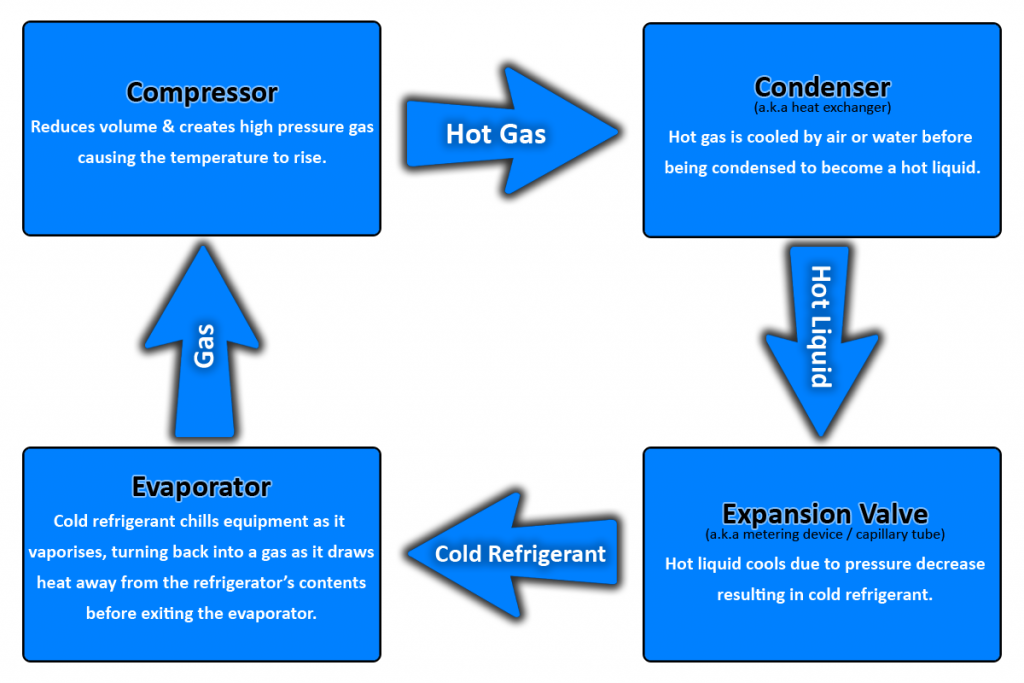
Refrigeration is an important aspect of both domestic and commercial food management. The creation of the first modern fridge in the late 1800's was an ushering of a great era in the food preservation and foodservice world. This has further been advanced by new technology which has seen a current production of more than 1 billion refrigerators around the world.
The one main reasons why refrigerators are used in businesses and at home is to keep food cold. Fridges are important because food stays fresh for longer, thus helping cut down wastage in foodservice settings. They also help increase profits in businesses by maintaining the quality of food for a longer time and allowing chefs the time and opportunity to create their best foods.
More production of food which is, in normal circumstances, highly perishable has increased the need to have storage mechanisms that prevent wastage and unwanted loss. However, as much as refrigeration is an important part of our lives, one question remains, how does a refrigerator work and how does it maintain such cold temperatures for a long time?
The Refrigeration Cycle Components
A standard refrigerator will have mechanical elements that make it easy for it to achieve and maintain cold temperatures. They are the components that will maintain the refrigeration cycle. These components are highly specialised in order to provide the desired effects.
They include a compressor, condenser, expansion valve/metering or throttling device and an evaporator. Additionally, the fridge has to use a refrigerant, a substance that is used to provide the cooling effect. The refrigerant has to pass through all these components and in each, it is altered to achieve the required temperatures.
Here are the refrigeration components that complete the cycle.

Compressor
Its work is to control the flow of the refrigerant by acting as a motor and a pump. This allows it to pressurise the refrigerant and reduce its volume.
There are five types of compressors used in both commercial and domestic refrigerators. They include reciprocating, rotary, screw, centrifugal and scroll. Of the five, the reciprocating compressor is the most commonly used in home and commercial kitchen refrigerators.
Condenser
The condenser works by condensing the refrigerant. The refrigerant entering the condenser is hot and pressurised. The condenser then cools the refrigerant by converting it into a liquid state.
There are three types of condensers.
Air-cooled. you will find this in small refrigerators such as the ones used at home. They are ideal when the refrigerant quantity is small. The air-cooled condenser is also called coil condenser because it comes with aluminium or copper coils at the back of the fridge. The coils increase the surface area for cooling the refrigerant.
Air-cooled condensers are further divided into two. The natural convection condenser which uses the natural flow of air to cool the refrigerant and the forced convection condenser which uses a fan to draw in cold air.
Water-cooled condensers. These are used in large plants where there is more refrigerant. They use water to provide the cooling effect on the refrigerant. Water-cooled refrigerants are further subdivided into three.
- Tube-in-tube or double pipe type
- Shell and coil type
- Shell and tube type
Water-cooled systems typically work better when operating in higher ambient temperatures.
Evaporative Condensers. These are used in ice plants and are a combination of water-cooled and air-cooled condensers. As such, they come with benefits from both types of condensers.
Expansion Valve
The expansion valve helps reduce the pressure and temperature of the refrigerant. The sudden drop in pressure and temperature produces a cooling effect.
The expansion valve also regulates the amount of refrigerant used in meeting the load requirements. The load, in this case, are the products that need cooling in the refrigerator.
There are various types of expansion valves. They include:
- Capillary Tube
- Constant Pressure or Automatic Throttling Valve
- Thermostatic Expansion Valve
- Float Valve
Evaporator
The evaporator absorbs heat inside the refrigerator. It acts as a medium of exchange for heat from the stored products (load) to the refrigerant. In most cases, the evaporator is the coldest part of the fridge or the freezer.
Here, the refrigerant is cold and moves at a slower pace in order to absorb as much heat as possible from the load. As it absorbs the heat, it gets hotter and turns into a gas. By vaporising the refrigerant more heat is absorbed from the load. The refrigerant, now hot and in gaseous form, is then pushed back into the compressor.
All types of commercial refrigeration will have these components, from commercial bottle coolers and multidecks to commercial chest freezers and cold rooms.
The Refrigeration Cycle

The refrigeration cycle starts and ends with the compressor. The refrigerant flows into the Compressor where it is compressed and pressurised. At this point, the refrigerant is a hot gas. The refrigerant is then pushed to the Condenser which turns the vapour into liquid and absorbs some of the heat. The refrigerant then proceeds to the Expansion Valve where it expands, losing pressure and heat.
The refrigerant coming out of the expansion valve is cold and slow due to the loss of pressure. It enters the Evaporator in a liquid state where the exchange of heat takes place thus cooling the load inside the refrigerator. As the gas cools down the load, it absorbs the heat which turns it into a gas. The gas is then pushed back into the Compressor where it can start the cycle again.
During the refrigeration cycle, a build-up of ice around the evaporator may occur. Both commercial fridges and freezers will combat this build-up with some form of defrost system. Read more about different types of defrosting function here.
Understanding the Refrigeration Cycle
The refrigeration cycle basically involves the movement of refrigerant from one place to the next and in different forms with the ultimate goal of pulling down temperatures whether in a cabinet, counter or even cold room format. The one main importance of learning how your commercial fridge works is so that you understand how to clean and maintain equipment effectively. For example, understanding that your fridge uses an air-cooled condenser will help you find the ideal position for your unit in order to make its work easier and lower the energy consumption. By understanding the basics, only then can one fully benefit from their commercial refrigeration.

Leave a Comment
Your email address will not be published. Required fields are marked *